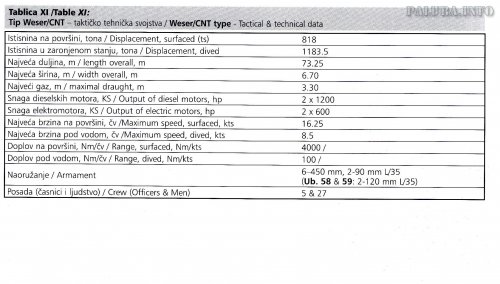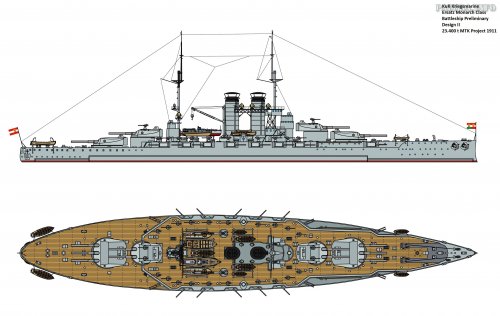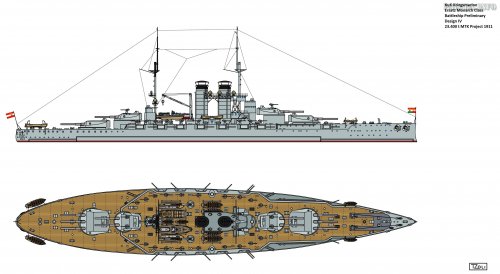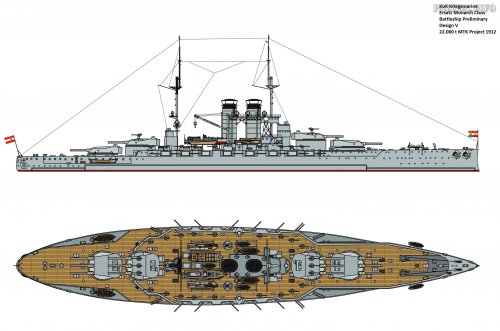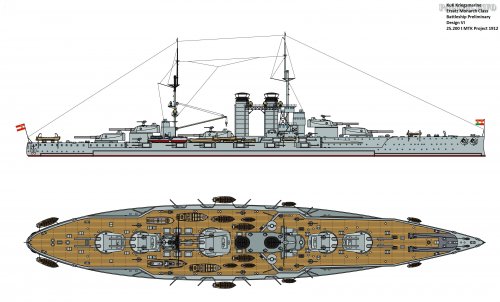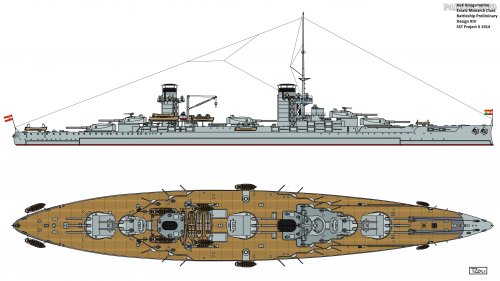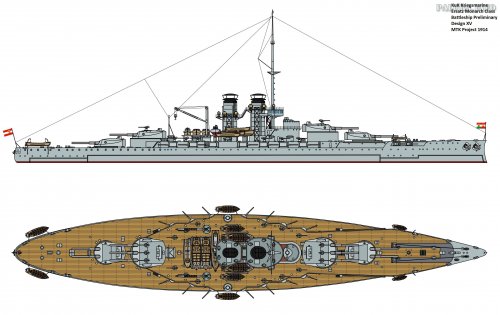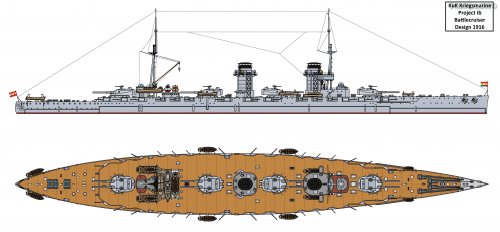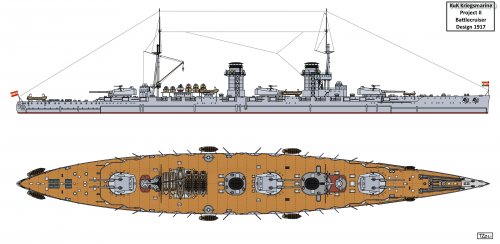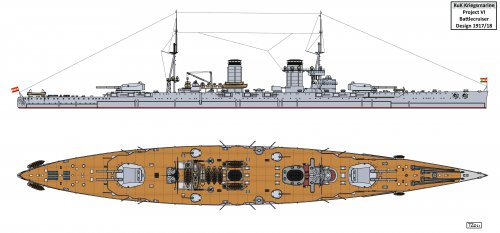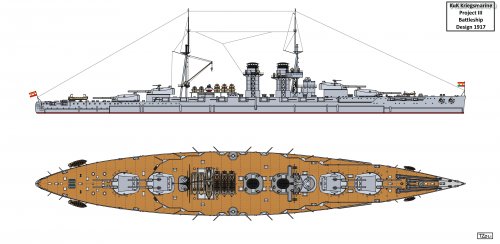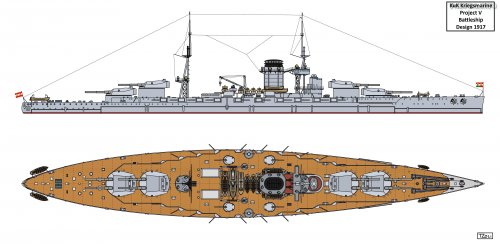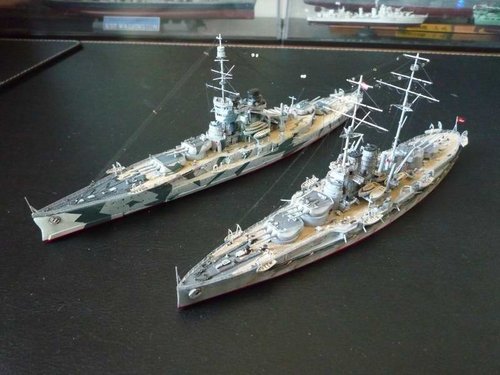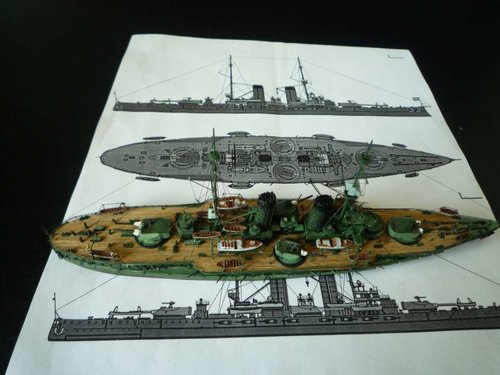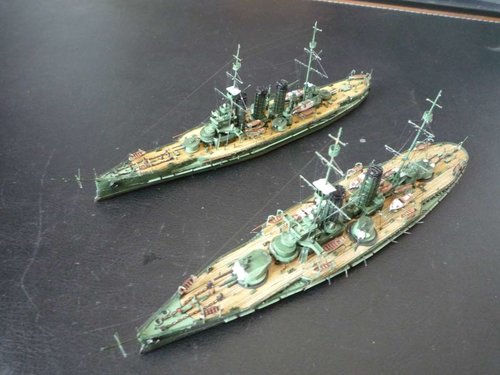- Joined
- 1 February 2011
- Messages
- 2,841
- Reaction score
- 3,264
I've posted this on WoW subforum of Warship Projects but it laced attention, but just in case I post this here as well:
The Austro-Hungarian Kaiserliche und Königliche Kriegsmarine (Imperial and Royal War Navy), abbreviated as K.u.K. Kriegsmarine like other navies of the world developed and proposed a number of designs of various warship classes which did not left the shipyard or the drawing board. Here I will show you the non capital ship proposals aka the cruisers, destroyers and monitors.
Monitors
To my current knowledge these are the only known monitor projects:
Number XI and XII River monitors (to be named SMS Duna and SMS Tisza) were the largest Danube monitors ever laid down. Ordered in 1917 and never finished, though some sources say they were launched in 1918.
Data on the design
Dimensions: 73,9m x 13m x 1,7m
Displacement: 1.240tons standard
Engine Power: 2.100shp, 2 shafts
Maximum Speed: 19km/h (10knots)
Armour: 40mm Belt, 25mm Deck
Armaments:
2x1 190mm Guns
2x2 90m Guns
4x1 37m Guns
1x1 90m AA Gun
Here is a model of this proposal from the Heeresgeschichtliches Museum, Wien:


Plans of one of the prelinianry studies of this design from 1916:


And based on these photos and drawings, I've made a technical drawing of it:

There was another monitor project during this time, it was also known as the Adria-Monitor Type, a pair of seagoing monitors were proposed at the end of 1917 to provide offshore fire support for the troops of the Dual Monarchy at the coasts of Italy. Not much is known about this design apart that they would displace 1500tons standard and would carry 2x 24cm cannons in 2 single turrets. None were laid down.
Based on the available data, the Duna Monitor and various similar sized monitors of other navies I've tried to-create this proposal:

Destroyers
Improved Tátra class Destroyers
8 destroyers of this class was authorised in September 1917, but only 4 units were actually ordered on 22nd of December, 1917. The steel shortage prevented their being laid down as only some 200tons of materials had reached the Shipyard at Porto Ré by the end of the war. The turbines and boilers, being built in Budapest were about 35% complete at the time.
Data on the design
Dimensions: 855m x 7,8m x 2,6m
Displacement: 880tons standard, 1.050tons full load
Engine Power: 20.500shp, 2 shafts
Maximum Speed: 60km/h (32,5knots)
Range: Unknown
Armaments:
2x1 120mm Guns
2x1 90m AA Gun
2x2 450mm Torpedo Tubes
Based on the data and the drawings of the existing Tátra class destroyers I've produced a drawing of it:

1.000ton Torepdo-Boat (Destroyer) design
In 1917 the admiralty planned new destroyers to not just replenish it's forces but expand them and continue the tradition of quality over quantity and designed both an 500ton and 1000ton ocean going fleet torpedo boats. While the 500ton torpedo boat was a true torpedo boat emphasizing speed and armament on a smaller hull and thus reduced range (this design was to be armed with 2x1 66mm guns and 2x2 53cm torpedoes with a speed of 61km/h (33knots) and 1850km range (1000nm)), this design considered too small for the admiralty and they choose the larger 1.000ton boat and the navy intended to build 12 such vessels.
The 1.000ton variant was to be armed with 3x1 12cm guns and 2x2 53cm torpedo tubes essentially double the firepower of the Tátra class destroyers while maintain a speed of 59km/h (32knots) for 20 hours and a range of 2800km (1500nm) at 37km/h (20knots). To achieve the high speed and required endurance the hull was made very economical hence the water drop shape which reduce resistance in water but on the other hand not provides much space on the aft as you can see. To provide space for the armament it was necessary to trunk as many funnels as possible and give a modern looking two funnelled ship with enough space to put the 3rd 12cm gun between them.
I wasn't able to find data about dimensions of these designs so a scaling of the drawing had to be done based on the Tatra drawings.
In the end the resulting dimensions as follows: length: 108,3m with a width of 10,5m and a draught of 3meters.
Official sketch of both the 500ton and 1000ton proposals:

Based on the data and drawing I was able to make this drawing:

1.600ton Destroyer Leader design
In 1917 the Admiralty of the Austro-Hungarian Navy ordered a new type of destroyer, to lead destroyer and torpedo boat flotillas. This ship would had enough fuel storage to travel to the Mediterranean sea and thus large enough to carry the necessary fuel but would had been armed with strong armament as well. Displacement was set to 1600tons, to reduce design time the plans of existing ships (Tátra class) to be used but reality shown that construction time would not change dramatically if using modified existing designs or entire new ones.
Multiple design studies were presented to the admiralty but there seems to be only 3 designs survived in the archives:
An offer from the Hungarian firm Ganz-Danubius (Ganz és Társa-Danubius Villamossági-, Gép-, Waggon- és Hajógyár Rt. - Ganz and Partner-Danubius Electrical- Machine-, Wagon- and Shipbuilding Co.), Fiume/Budapest as follows:
Dimensions: 109,6 x 9,4 x 3m
Displacement: 1.615tons standard, 2.093tons full load
Engine Power: 41.000shp 2 shafts, 63km/h (34knots)
Armament: 2x1 15cm or 4x1 12cm guns, 2x AA guns, 2x2 53cm torpedo tubes
Another offer was from the MTK (Marinetechnische Komitee - Naval Technical Committee), Pola / Vienna as follows:
Dimensions: 110 x 9,5 x 2,9m
Displacement: 1.500tons standard, 1.900tons full load
Engine Power: 36.000shp 2 shafts, 65km/h (35knots)
Armament: 6x1 10cm guns, no mention of AA guns though, 4x2 53cm torpedo tubes
And there was an offer even from the German shipyard of Blohm & Voss, Hamburg which was producing destroyers for the German Navy:
Dimensions: 96,9 x 9,35 x 2,8m
Displacement: 1.320tons standard, 1.780tons full load
Engine Power: 30.700shp 2 shafts, 65km/h (35knots)
Armament: 4x1 10,5cm guns, no mention of AA guns though, 2x2,2x1 or 3x2 53cm torpedo tubes
Ganz-Danubius proposal:

MTK and Blohm & Voss proposals:

Here are my drawings of the MTK and Ganz-Danubius proposals based on the data above:

1.900-2.000ton Destroyer design
8 destroyers of 1900tons were authorised in September 1917, while the next month the Naval Technical Committee (K.u.K. Marinetechnisches Komitee) issued a specification for a 2000ton destroyer with the following details:
Dimensions: 115m x 10m x 3,8m
Maximum Speed: 63km/h (34knots)
Armaments: 4x1 15cm L/50, 4x1 6,6cm L/50 AA, 6x 53cm Torpedo Tubes
Two shipyards were invited to put forward their suggestions in line with this specification. Ganz-Danubius Fiume tendered their project in April 1918. The ships would had the following details:
Dimensions: 122,4m x 10,2m x 6,8m
Displacement: 2.272tons standard, 2.498tons full load
Engine Power: 43.000shp, 2 shafts
Maximum Speed: 63km/h (34knots)
Range: 5.600km at 30km/h (3.000nm at 16knots)
Armaments:
4x1 150mm Guns
4x1 105m AA Gun
2x2 533mm Torpedo Tubes
It was not until the 15th of August, 1918 that STT submitted alternative proposals for a 2440ton destroyer armed with 3x1 15cm guns and another 2650ton destroyer armed with 4x1 15cm guns:
Dimensions: 122,4m x 10,2m x 6,8m
Displacement: around 2.300tons standard, 2.650tons full load
Engine Power: 43.000shp 2 shafts
Maximum Speed: 63km/h (34knots)
Range: 5.600km at 30km/h (3.000nm at 16knots)
Armaments:
4x1 150mm Guns
4x1 66m AA Gun
3x2 533mm Torpedo Tubes (originally 2x2 but soon changed to 3x2)
This project was approved but the situation deteriorated rapidly and no vessels were ordered.
Original sketch drawings of both the MTK and Ganz-Danubius proposals:

And my drawing based on the above sketches and data:

Cruisers
There were a number of cruisers designs during WW I including the 3+1 intended for China:
The large or great China cruiser:
In 1913 the Chinese government ordered 4 cruisers of two different designs from Cantiere Navale Trietino, Monfalcone (CNT). These were cruiser number 65,66,67 as well as 68 for the large cruiser. Preparatory work began in December 1914, the keel of the large Chinese cruiser being laid in March 1915. Her armament and armour were to be provided by the Skoda Works, while the turbines were to come from Ganz & Danubius AG, Budapest.
When Italy declared war on Austria-Hungary, only parts of the keel and some frames were erected. When Austrian troops recaptured the area in the 27th of October, 1917, these 4 cruisers showed remarkably little damage because construction was so little advanced.
The design of the large Chinese cruiser could be easily reworked to Austro-Hungarian standards, the 37.000shp turbine set and the entire boiler system were ready for delivery, and 31% of the hull material was already stockpiled, so plans were drawn up in April, 1918 to restart work on her but she was scrapped on the stocks postwar.
Original Design:
Dimensions: 137m x 14,68m x 4,88m
Displacement: 4.900tons standard
Engine Power: 37.000shp, 2 shafts
Maximum Speed: 52km/h (28knots)
Range: 5.600km at 24km/h (3.000nm at 13knots)
Armour: 100mm Belt, 63mm Deck
Armaments:
2x2 203mm Guns
12x1 120mm Guns
10x1 47mm Guns
4x1 37mm Guns
2x1 450mm Torpedo Tubes

Revised design for the KuK Marine:
Dimensions: 137m x 14,68m x 4,88m
Displacement: 4.900tons standard, 5350tons full load
Engine Power: 37.000shp, 2 shafts
Maximum Speed: 52km/h (28knots)
Range: 5.600km at 24km/h (3.000nm at 13knots)
Armour: 100mm Belt, 63mm Deck
Armaments:
8x1 150mm Guns
2x1 90mm AA Guns
2x2 450mm Torpedo Tubes

The small China cruisers:
Three small cruisers ordered in September 1913 that were to be built in 22-26 months from start of construction. Their armament was to be supplied by Skoda. All three were begun by early 1915 but Italian troops seized them on the stocks, when recaptured by the Austrian troops they had very little damage. Plans were envisioned to finish them to a simpler design featuring a revised armament.
Original Design:
Dimensions: 109,7m x 10,9m x 4m
Displacement: 1.800tons standard
Engine Power: 30.000shp, 2 shafts
Maximum Speed: 59km/h (35knots)
Range: Unknown
Armour: 0mm Belt, 25mm Deck
Armaments:
10x1 100mm Guns
4x1 47mm Guns
2x1 450mm Torpedo Tubes

 www.deviantart.com
www.deviantart.com
Revised design for the KuK Marine:
Dimensions: 109,7m x 10,9m x 4m
Displacement: 1.800tons standard
Engine Power: 30.000shp, 2 shafts
Maximum Speed: 59km/h (35knots)
Range: Unknown
Armour: 0mm Belt, 25mm Deck
Armaments:
4x1 120mm Guns
8x1 66mm Guns
4x1 47mm Guns
2x1 450mm Torpedo Tubes

 www.deviantart.com
www.deviantart.com
Ersatz Zenta class (Replacement Zenta class:
3 fast light cruisers, essentially scout cruisers, authorized on 28th of May, 1914, in the same 1914-15 naval budget as the Ersatz Monarch or improved Tegetthoffs. These cruisers were a continuation of and improvement on the previous designs, showing a clear switch from the scout role to the better armed fleet cruiser. 3 naval engineers proposed designs for the requirement of such cruisers: Franz Pitzinger, Silvius Morin and Johann Fiala, but only Fiala's desings were taken into consideration, but before a clear decision in favour of any one was taken, war broke out and the laying down of the first unit was postponed.
In December 1915, although Italy had now entered the war, the Naval Command demanded changes in the cruiser design which clearly reflected the lessons of the first year of the war and also the urgent need for fast but better armed cruisers for Adriatic warfare: more powerful main artillery, heavier AA guns and increased belt armour.
Other designers variants:

 stefsap.wordpress.com
stefsap.wordpress.com
Original Design:
Dimensions: 153,1m x 13,7m x 6,4m
Displacement: 4.950tons standard, 5.611 full load
Engine Power: 38.000shp, 2 shafts
Maximum Speed: 56km/h (30knots)
Range: Unknown
Armour: 20mm Belt, 38mm Deck
Armaments:
14x1 120mm Guns
1x1 47mm Gun
2x1 450mm Torpedo Tubes
Franz Pitzinger's Design:
Johann Fiala's Project Ia:
Project Ib:

 www.deviantart.com
Project II:
www.deviantart.com
Project II:
Project IIb:
Silvius Morin's Design:


Silvius Morin's variant:

Revised design:
Dimensions: 153,1m x 13,7m x 6,4m
Displacement: 8.640tons standard
Engine Power: 38.000shp, 2 shafts
Maximum Speed: 56km/h (30knots)
Range: Unknown
Armour: 150mm Belt, 38mm Deck
Armaments:
2x1 190mm Guns
6x1 150mm Guns
4x1 90mm AA Guns
1x2 533mm Torpedo Tubes
Project VII Heavy Cruiser
This design of a heavily armed and armoured cruiser first proposed for the Technical Committee of the Navy by Franz Pitzinger in 1917 and approved by the 1st of August, 1918. Apparently as the design emerged shortly after the British Hawkins class cruisers were launched and the Emerald class light cruisers under construction it is logical that the two navies designers concluded the same experience from war lessons.
Data on the design
Dimensions: 184,5m x 18,2m x 6,45m
Displacement: 10.000tons standard, 12.000tons full load
Engine Power: 90.000shp, 2 shafts
Maximum Speed: 61km/h (33knots)
Range: 12.900km at 37km/h (7.000nm at 20knots)
Armour: 150mm Belt, 30mm Deck
Armaments:
3x2 190mm Guns
4x1 90m AA Gun
2x1 533mm Underwater Torpedo Tubes
View: http://i.imgur.com/fLPTQ6y.png

The above mentioned data and designs are from these books::
Conway's All the World's Fighting Ships 1906-1921,
Austro-Hungarian Warships of World War I by René Greger and
Warship International, No3, 1978, by Anthony Sokol.
The Austro-Hungarian Kaiserliche und Königliche Kriegsmarine (Imperial and Royal War Navy), abbreviated as K.u.K. Kriegsmarine like other navies of the world developed and proposed a number of designs of various warship classes which did not left the shipyard or the drawing board. Here I will show you the non capital ship proposals aka the cruisers, destroyers and monitors.
Monitors
To my current knowledge these are the only known monitor projects:
Number XI and XII River monitors (to be named SMS Duna and SMS Tisza) were the largest Danube monitors ever laid down. Ordered in 1917 and never finished, though some sources say they were launched in 1918.
Data on the design
Dimensions: 73,9m x 13m x 1,7m
Displacement: 1.240tons standard
Engine Power: 2.100shp, 2 shafts
Maximum Speed: 19km/h (10knots)
Armour: 40mm Belt, 25mm Deck
Armaments:
2x1 190mm Guns
2x2 90m Guns
4x1 37m Guns
1x1 90m AA Gun
Here is a model of this proposal from the Heeresgeschichtliches Museum, Wien:


Plans of one of the prelinianry studies of this design from 1916:


And based on these photos and drawings, I've made a technical drawing of it:

There was another monitor project during this time, it was also known as the Adria-Monitor Type, a pair of seagoing monitors were proposed at the end of 1917 to provide offshore fire support for the troops of the Dual Monarchy at the coasts of Italy. Not much is known about this design apart that they would displace 1500tons standard and would carry 2x 24cm cannons in 2 single turrets. None were laid down.
Based on the available data, the Duna Monitor and various similar sized monitors of other navies I've tried to-create this proposal:

Destroyers
Improved Tátra class Destroyers
8 destroyers of this class was authorised in September 1917, but only 4 units were actually ordered on 22nd of December, 1917. The steel shortage prevented their being laid down as only some 200tons of materials had reached the Shipyard at Porto Ré by the end of the war. The turbines and boilers, being built in Budapest were about 35% complete at the time.
Data on the design
Dimensions: 855m x 7,8m x 2,6m
Displacement: 880tons standard, 1.050tons full load
Engine Power: 20.500shp, 2 shafts
Maximum Speed: 60km/h (32,5knots)
Range: Unknown
Armaments:
2x1 120mm Guns
2x1 90m AA Gun
2x2 450mm Torpedo Tubes
Based on the data and the drawings of the existing Tátra class destroyers I've produced a drawing of it:

1.000ton Torepdo-Boat (Destroyer) design
In 1917 the admiralty planned new destroyers to not just replenish it's forces but expand them and continue the tradition of quality over quantity and designed both an 500ton and 1000ton ocean going fleet torpedo boats. While the 500ton torpedo boat was a true torpedo boat emphasizing speed and armament on a smaller hull and thus reduced range (this design was to be armed with 2x1 66mm guns and 2x2 53cm torpedoes with a speed of 61km/h (33knots) and 1850km range (1000nm)), this design considered too small for the admiralty and they choose the larger 1.000ton boat and the navy intended to build 12 such vessels.
The 1.000ton variant was to be armed with 3x1 12cm guns and 2x2 53cm torpedo tubes essentially double the firepower of the Tátra class destroyers while maintain a speed of 59km/h (32knots) for 20 hours and a range of 2800km (1500nm) at 37km/h (20knots). To achieve the high speed and required endurance the hull was made very economical hence the water drop shape which reduce resistance in water but on the other hand not provides much space on the aft as you can see. To provide space for the armament it was necessary to trunk as many funnels as possible and give a modern looking two funnelled ship with enough space to put the 3rd 12cm gun between them.
I wasn't able to find data about dimensions of these designs so a scaling of the drawing had to be done based on the Tatra drawings.
In the end the resulting dimensions as follows: length: 108,3m with a width of 10,5m and a draught of 3meters.
Official sketch of both the 500ton and 1000ton proposals:

Based on the data and drawing I was able to make this drawing:

1.600ton Destroyer Leader design
In 1917 the Admiralty of the Austro-Hungarian Navy ordered a new type of destroyer, to lead destroyer and torpedo boat flotillas. This ship would had enough fuel storage to travel to the Mediterranean sea and thus large enough to carry the necessary fuel but would had been armed with strong armament as well. Displacement was set to 1600tons, to reduce design time the plans of existing ships (Tátra class) to be used but reality shown that construction time would not change dramatically if using modified existing designs or entire new ones.
Multiple design studies were presented to the admiralty but there seems to be only 3 designs survived in the archives:
An offer from the Hungarian firm Ganz-Danubius (Ganz és Társa-Danubius Villamossági-, Gép-, Waggon- és Hajógyár Rt. - Ganz and Partner-Danubius Electrical- Machine-, Wagon- and Shipbuilding Co.), Fiume/Budapest as follows:
Dimensions: 109,6 x 9,4 x 3m
Displacement: 1.615tons standard, 2.093tons full load
Engine Power: 41.000shp 2 shafts, 63km/h (34knots)
Armament: 2x1 15cm or 4x1 12cm guns, 2x AA guns, 2x2 53cm torpedo tubes
Another offer was from the MTK (Marinetechnische Komitee - Naval Technical Committee), Pola / Vienna as follows:
Dimensions: 110 x 9,5 x 2,9m
Displacement: 1.500tons standard, 1.900tons full load
Engine Power: 36.000shp 2 shafts, 65km/h (35knots)
Armament: 6x1 10cm guns, no mention of AA guns though, 4x2 53cm torpedo tubes
And there was an offer even from the German shipyard of Blohm & Voss, Hamburg which was producing destroyers for the German Navy:
Dimensions: 96,9 x 9,35 x 2,8m
Displacement: 1.320tons standard, 1.780tons full load
Engine Power: 30.700shp 2 shafts, 65km/h (35knots)
Armament: 4x1 10,5cm guns, no mention of AA guns though, 2x2,2x1 or 3x2 53cm torpedo tubes
Ganz-Danubius proposal:

MTK and Blohm & Voss proposals:

Here are my drawings of the MTK and Ganz-Danubius proposals based on the data above:

1.900-2.000ton Destroyer design
8 destroyers of 1900tons were authorised in September 1917, while the next month the Naval Technical Committee (K.u.K. Marinetechnisches Komitee) issued a specification for a 2000ton destroyer with the following details:
Dimensions: 115m x 10m x 3,8m
Maximum Speed: 63km/h (34knots)
Armaments: 4x1 15cm L/50, 4x1 6,6cm L/50 AA, 6x 53cm Torpedo Tubes
Two shipyards were invited to put forward their suggestions in line with this specification. Ganz-Danubius Fiume tendered their project in April 1918. The ships would had the following details:
Dimensions: 122,4m x 10,2m x 6,8m
Displacement: 2.272tons standard, 2.498tons full load
Engine Power: 43.000shp, 2 shafts
Maximum Speed: 63km/h (34knots)
Range: 5.600km at 30km/h (3.000nm at 16knots)
Armaments:
4x1 150mm Guns
4x1 105m AA Gun
2x2 533mm Torpedo Tubes
It was not until the 15th of August, 1918 that STT submitted alternative proposals for a 2440ton destroyer armed with 3x1 15cm guns and another 2650ton destroyer armed with 4x1 15cm guns:
Dimensions: 122,4m x 10,2m x 6,8m
Displacement: around 2.300tons standard, 2.650tons full load
Engine Power: 43.000shp 2 shafts
Maximum Speed: 63km/h (34knots)
Range: 5.600km at 30km/h (3.000nm at 16knots)
Armaments:
4x1 150mm Guns
4x1 66m AA Gun
3x2 533mm Torpedo Tubes (originally 2x2 but soon changed to 3x2)
This project was approved but the situation deteriorated rapidly and no vessels were ordered.
Original sketch drawings of both the MTK and Ganz-Danubius proposals:

And my drawing based on the above sketches and data:

Cruisers
There were a number of cruisers designs during WW I including the 3+1 intended for China:
The large or great China cruiser:
In 1913 the Chinese government ordered 4 cruisers of two different designs from Cantiere Navale Trietino, Monfalcone (CNT). These were cruiser number 65,66,67 as well as 68 for the large cruiser. Preparatory work began in December 1914, the keel of the large Chinese cruiser being laid in March 1915. Her armament and armour were to be provided by the Skoda Works, while the turbines were to come from Ganz & Danubius AG, Budapest.
When Italy declared war on Austria-Hungary, only parts of the keel and some frames were erected. When Austrian troops recaptured the area in the 27th of October, 1917, these 4 cruisers showed remarkably little damage because construction was so little advanced.
The design of the large Chinese cruiser could be easily reworked to Austro-Hungarian standards, the 37.000shp turbine set and the entire boiler system were ready for delivery, and 31% of the hull material was already stockpiled, so plans were drawn up in April, 1918 to restart work on her but she was scrapped on the stocks postwar.
Original Design:
Dimensions: 137m x 14,68m x 4,88m
Displacement: 4.900tons standard
Engine Power: 37.000shp, 2 shafts
Maximum Speed: 52km/h (28knots)
Range: 5.600km at 24km/h (3.000nm at 13knots)
Armour: 100mm Belt, 63mm Deck
Armaments:
2x2 203mm Guns
12x1 120mm Guns
10x1 47mm Guns
4x1 37mm Guns
2x1 450mm Torpedo Tubes

Revised design for the KuK Marine:
Dimensions: 137m x 14,68m x 4,88m
Displacement: 4.900tons standard, 5350tons full load
Engine Power: 37.000shp, 2 shafts
Maximum Speed: 52km/h (28knots)
Range: 5.600km at 24km/h (3.000nm at 13knots)
Armour: 100mm Belt, 63mm Deck
Armaments:
8x1 150mm Guns
2x1 90mm AA Guns
2x2 450mm Torpedo Tubes

The small China cruisers:
Three small cruisers ordered in September 1913 that were to be built in 22-26 months from start of construction. Their armament was to be supplied by Skoda. All three were begun by early 1915 but Italian troops seized them on the stocks, when recaptured by the Austrian troops they had very little damage. Plans were envisioned to finish them to a simpler design featuring a revised armament.
Original Design:
Dimensions: 109,7m x 10,9m x 4m
Displacement: 1.800tons standard
Engine Power: 30.000shp, 2 shafts
Maximum Speed: 59km/h (35knots)
Range: Unknown
Armour: 0mm Belt, 25mm Deck
Armaments:
10x1 100mm Guns
4x1 47mm Guns
2x1 450mm Torpedo Tubes

Monfalcone type Small Cruiser Design for China by Tzoli on DeviantArt
Revised design for the KuK Marine:
Dimensions: 109,7m x 10,9m x 4m
Displacement: 1.800tons standard
Engine Power: 30.000shp, 2 shafts
Maximum Speed: 59km/h (35knots)
Range: Unknown
Armour: 0mm Belt, 25mm Deck
Armaments:
4x1 120mm Guns
8x1 66mm Guns
4x1 47mm Guns
2x1 450mm Torpedo Tubes

Monfalcone type Small Cruiser Design V2 for China by Tzoli on DeviantArt
Ersatz Zenta class (Replacement Zenta class:
3 fast light cruisers, essentially scout cruisers, authorized on 28th of May, 1914, in the same 1914-15 naval budget as the Ersatz Monarch or improved Tegetthoffs. These cruisers were a continuation of and improvement on the previous designs, showing a clear switch from the scout role to the better armed fleet cruiser. 3 naval engineers proposed designs for the requirement of such cruisers: Franz Pitzinger, Silvius Morin and Johann Fiala, but only Fiala's desings were taken into consideration, but before a clear decision in favour of any one was taken, war broke out and the laying down of the first unit was postponed.
In December 1915, although Italy had now entered the war, the Naval Command demanded changes in the cruiser design which clearly reflected the lessons of the first year of the war and also the urgent need for fast but better armed cruisers for Adriatic warfare: more powerful main artillery, heavier AA guns and increased belt armour.
Other designers variants:

Austria-Hungary’s Naval Building Projects 1914-1918 – Cruisers
Source Warship International, N°3, 1978, by Anthony Sokol. Check the second part, devoted to destroyers and minor vessels here, This article covers these specific designs: Pitzinger’s design;…
Original Design:
Dimensions: 153,1m x 13,7m x 6,4m
Displacement: 4.950tons standard, 5.611 full load
Engine Power: 38.000shp, 2 shafts
Maximum Speed: 56km/h (30knots)
Range: Unknown
Armour: 20mm Belt, 38mm Deck
Armaments:
14x1 120mm Guns
1x1 47mm Gun
2x1 450mm Torpedo Tubes
Franz Pitzinger's Design:
Johann Fiala's Project Ia:
Project Ib:

Ersatz Zenta Preliminary Project Ib by Tzoli on DeviantArt
Project IIb:
Silvius Morin's Design:


Silvius Morin's variant:

Revised design:
Dimensions: 153,1m x 13,7m x 6,4m
Displacement: 8.640tons standard
Engine Power: 38.000shp, 2 shafts
Maximum Speed: 56km/h (30knots)
Range: Unknown
Armour: 150mm Belt, 38mm Deck
Armaments:
2x1 190mm Guns
6x1 150mm Guns
4x1 90mm AA Guns
1x2 533mm Torpedo Tubes
Project VII Heavy Cruiser
This design of a heavily armed and armoured cruiser first proposed for the Technical Committee of the Navy by Franz Pitzinger in 1917 and approved by the 1st of August, 1918. Apparently as the design emerged shortly after the British Hawkins class cruisers were launched and the Emerald class light cruisers under construction it is logical that the two navies designers concluded the same experience from war lessons.
Data on the design
Dimensions: 184,5m x 18,2m x 6,45m
Displacement: 10.000tons standard, 12.000tons full load
Engine Power: 90.000shp, 2 shafts
Maximum Speed: 61km/h (33knots)
Range: 12.900km at 37km/h (7.000nm at 20knots)
Armour: 150mm Belt, 30mm Deck
Armaments:
3x2 190mm Guns
4x1 90m AA Gun
2x1 533mm Underwater Torpedo Tubes
View: http://i.imgur.com/fLPTQ6y.png

The above mentioned data and designs are from these books::
Conway's All the World's Fighting Ships 1906-1921,
Austro-Hungarian Warships of World War I by René Greger and
Warship International, No3, 1978, by Anthony Sokol.
Last edited:

